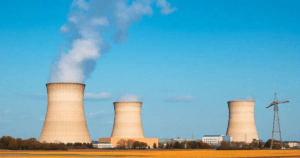India’s Nuclear Energy Boom: 100 GW Goal Sparks a Game-Changing Revolution by 2047
India is making significant strides in nuclear energy to meet its growing electricity demand while reducing reliance on fossil fuels. With power needs expected to triple by 2047, nuclear energy offers a reliable and low-carbon solution. The country has expanded its nuclear capacity by over 70% in the last decade, reaching 8,180 MW, with 21 new reactors adding 15,300 MW in the pipeline. A major breakthrough was the successful commissioning of the indigenous 700 MWe PHWR at Kakrapar, strengthening India’s self-reliance in nuclear technology.
The government is also investing ₹20,000 crore in Small Modular Reactors (SMRs) to power industries and promote decarbonization. To accelerate growth, India is amending laws to encourage private sector participation and forming global partnerships, including a planned 1,208 MW project with the US in Andhra Pradesh. The long-term target is an ambitious 100 GW of nuclear capacity by 2047, driving India towards clean energy self-sufficiency. With strong safety standards and a focus on public acceptance, nuclear energy is set to play a transformative role in India’s future.

India’s Nuclear Energy Boom: 100 GW Goal Sparks a Game-Changing Revolution by 2047
India is rapidly expanding its nuclear energy capabilities to meet soaring electricity demands, driven by government funding and strategic planning. As one of the world’s fastest-growing economies, the country faces a triple challenge: skyrocketing power needs, reducing carbon emissions, and cutting reliance on fossil fuels. By 2047, India’s electricity demand is projected to triple, pushing the government to prioritize clean, reliable energy sources. Nuclear power, which produces minimal greenhouse gases and operates round-the-clock, has emerged as a crucial solution.
Why Nuclear?
Currently, nearly 70% of India’s energy comes from coal and oil, making it difficult to balance economic growth with climate goals. Nuclear energy offers a way out. Countries like France, which generates over 70% of its electricity from nuclear plants, demonstrate its viability as a stable, large-scale power source. Unlike solar or wind energy, which depends on weather conditions, nuclear reactors provide uninterrupted electricity—a crucial advantage for industries and households alike.
India’s Nuclear Evolution
India’s nuclear journey began in 1948 with the establishment of the Atomic Energy Commission. The first research reactor, Apsara, was launched in 1956, marking the nation’s entry into atomic energy. Over decades, India built expertise despite global sanctions, focusing on self-reliance. Today, 24 operational reactors contribute 8,180 MW to the grid, with 21 more under construction, set to add 15,300 MW.
A landmark achievement came in 2023-24 with the launch of India’s first fully homegrown 700 MW Pressurised Heavy Water Reactor (PHWR) in Gujarat. This reactor type uses natural uranium and heavy water, optimizing resource efficiency. Additionally, advancements in Fast Breeder Reactors—which produce more fuel than they consume—pave the way for future thorium-based reactors, leveraging India’s vast thorium reserves.
Innovation and Private Sector Collaboration
To accelerate growth, India is investing in Small Modular Reactors (SMRs)—compact, factory-built units ideal for industrial use. The 2024 budget allocated ₹20,000 crore ($2.4 billion) for SMR research, with a goal of deploying five operational units by 2033. These reactors could decarbonize industries like steel and cement, providing steady power without carbon emissions.
Breaking from tradition, India is opening its nuclear sector to private investment. Recent policy changes allow companies to partner with the state-owned Nuclear Power Corporation of India Limited (NPCIL). A notable collaboration is the NPCIL-NTPC joint venture, ASHVINI, which focuses on developing new projects. This shift aims to attract capital and expertise, accelerating capacity expansion.
Global Partnerships and Long-Term Vision
India is strengthening international ties to boost its nuclear program. Partnerships with Russia, France, and the U.S. play a key role. For instance, a U.S.-backed project in Andhra Pradesh plans to build six reactors with a combined capacity of 7,248 MW. The long-term goal is to reach 100 GW of nuclear capacity by 2047—a twelvefold increase from current levels—as part of the “Nuclear Energy Mission for Viksit Bharat” (Developed India).
Addressing Safety Concerns
Safety remains a priority. India adheres to strict regulatory standards, with radiation levels at nuclear plants consistently below global limits. At the Kudankulam plant, emissions have dropped by 99% over a decade, reflecting improved safety protocols. Public awareness campaigns aim to dispel myths and build trust by emphasizing transparency and community engagement.
The Road Ahead
Scaling nuclear energy requires balancing rapid growth with safety, public acceptance, and funding. While renewables like solar and wind will play a role, nuclear’s reliability makes it indispensable for base-load power. By combining innovation, private investment, and global collaboration, India aims to achieve energy independence and a net-zero future.
In summary, nuclear energy is central to India’s strategy for sustainable growth. With bold targets, technological advancements, and evolving policies, the country is poised to transform its energy landscape, ensuring a cleaner, self-reliant future.
You must be logged in to post a comment.